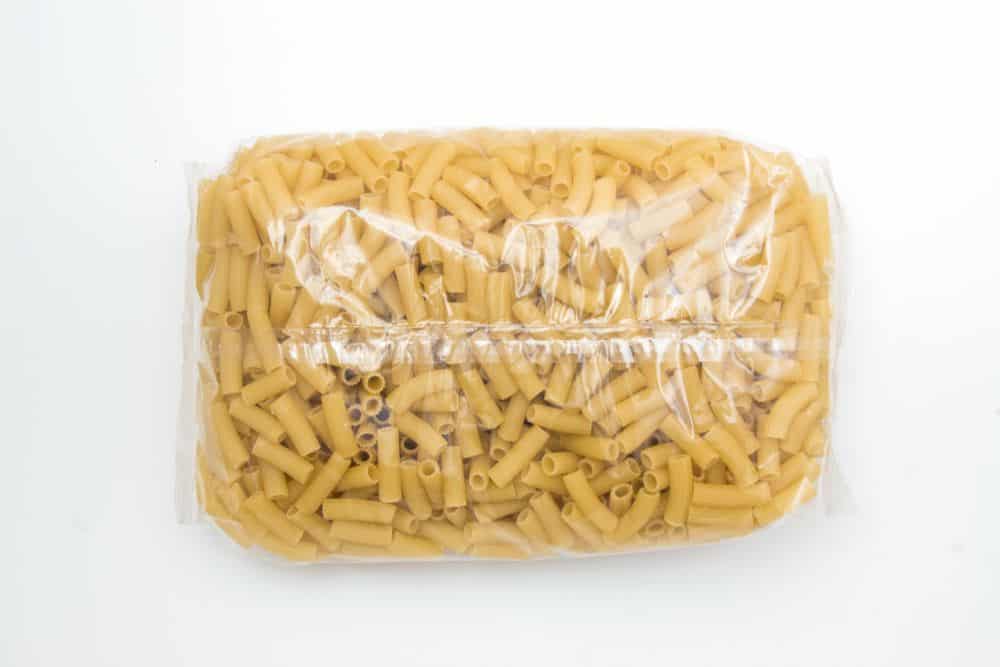Spaghetti. Lasagna. Penne. Fettuccine. Rotini. Ravioli. Tortellini. Macaroni. One or several of those words likely made your mouth start watering. Whether you imagine a rich, hearty meat and tomato sauce or a delicate buttery version full of fresh herbs, the word: pasta is often synonymous with good, satisfying food.
As an average American, you consume around 20 pounds of pasta each year and probably enjoy every bite.
Nearly 6 billion pounds of pasta are consumed in the United States annually, and it is the sixth highest food per capita. The U.S. is the second largest pasta-producing country at 4.4 billion pounds every year.
Pasta is a tremendously versatile food. It accompanies the boxed mac & cheese every kid craves and lobster with garlic and herb butter sauce in a fine dining restaurant with equal ease.
Pasta does not receive credit as an ideal meal for the health-conscious, mainly due to the carb content. However, pasta eaters tend to have an overall higher quality diet than those who do not eat pasta.
The nutritional value of pasta depends, of course, on the type and ingredients. It is mainly influenced by what is in the sauce that pasta is rarely without.
If you want to make your favorite pasta dish a bit healthier, homemade pasta is the best option.
You may think that store-bought pasta is just a dried or dehydrated version of fresh or homemade pasta, but that is not the case.
Dried, boxed pasta is made in a completely different way than you would make fresh pasta at home.

The difference between store-bought and homemade pasta is the use of eggs in the dough.
That ingredient creates several variations between dried pasta and fresh.
Fresh pasta:
Dry pasta:

When determining how healthy a food is, ingredients are the deciding factor. No claims on the labels can override the importance of what is actually in the food.
Most dried pasta is a combination of semolina flour, which is a coarse wheat flour made from durum wheat, along with water and salt. They rarely contain eggs unless they are egg noodles.
Homemade pasta contains flour, eggs, possibly oil, water, and salt. Semolina flour is usually the best choice for flour because it creates the best texture. However, you could also use all-purpose or bread flour, especially if you need a heartier texture to stand up to a heavier pasta sauce.
Since homemade and dry pasta contains many of the same ingredients, their nutrition profiles are not very different. You can see below how they compare regarding nutrients, but remember that not all pasta recipes are the same. These are just examples, and you should research the recipe of your noodles for an exact comparison.
Using these examples, however, you can see that homemade pasta tends to be lower in calories and carbohydrates, so if you try to keep your consumption of those to a minimum, homemade pasta may be a better choice. It also has more vitamin A than dry pasta.
On the other hand, regular pasta has less fat and more protein. It also contains slightly more calcium and iron and significantly more potassium than homemade while being lower in cholesterol and sodium.
Overall, one is not more healthy than the other. They each have advantages and disadvantages, and you should consider your unique dietary needs when deciding which is healthier for you.
For instance, if you are vegan, you will want to avoid homemade pasta since it contains eggs. Store-bought dry pasta made with flour, water, and salt is vegan pasta.
Dry store-bought pasta contains around 310 calories per 1 cup serving, 1.3 grams of fat, 62.7 grams of carbohydrates, and 11 grams of protein. Other nutrients it supplies include:
It also has 4 mg of sodium.
Homemade egg pasta has around 185 calories per 1 cup serving, 2.5 grams of fat, 33.4 grams of carbohydrates, and 7.5 grams of protein. It also contains other nutrients, including:
It also has 58 mg of cholesterol and 118 mg of sodium.
One of the main advantages of making foods from scratch is that you have total control over the ingredients. While boxed pasta typically does not have many unnecessary ingredients, some types and brands may have artificial preservatives added to them.

Some companies add substances such as potassium sorbate and sodium benzoate to their boxed pasta. Though generally regarded as safe food additives, these substances can cause undesirable effects.
Sodium benzoate is commonly used as a food preservative. Some studies have shown it to have immunosuppressive properties, and though this has not been conclusively proven, you may wish to limit the amount of sodium benzoate you consume, just to be safe.
Countries like Brazil, Canada, China, and the European Union have banned potassium sorbate for potentially causing cancer. Though it is labeled as GRAS (generally regarded as safe) by the FDA, that designation has little science to back it up.
Generally, the fewer ingredients, and the fewer additives, in the food you consume, the better it is for you. Making food from scratch is an excellent way to control everything that goes into your food.
You may choose to use one type of pasta or the other solely for health or nutrition reasons. However, since they have different characteristics, sometimes, a specific variety of pasta will work better than the other in a recipe.
Homemade pasta is delicate. It works well with light sauces that use butter or cream as a base. Pesto and marinara sauces also pair well with homemade pasta. Any recipe that calls for egg noodles should also work with homemade pasta since they contain nearly identical ingredients.
Dry pasta is more sturdy. Since it requires more cooking time anyway, it is ideal for dishes like soups and casseroles, where it is cooked for a longer time. It may also be more suitable than homemade pasta in dishes with heavier, richer sauces.
You may also prefer dry pasta in dishes that include larger components, such as broccoli since dry pasta is sturdy enough to stand up to it. Dishes that will be frozen or made ahead of time, such as pasta salad, also benefit from the sturdier dry pasta.
Homemade pasta has several benefits beyond having control over the ingredients. It has a fresher taste than boxed pasta, and it has a texture that some people describe as “decadent” or “luxurious.”
You can mold the pasta into whatever shape you need for the recipe you are making. However, you do need specialized equipment to make some shapes.
Since homemade pasta is made from flour, water, and eggs, you likely have everything you need on hand at any time. And since these ingredients tend to be inexpensive, homemade pasta is usually cheaper than store-bought.
You can also customize homemade pasta. For instance, if you prefer, you can make whole wheat pasta or choose alternate grains to fit your specific dietary needs.
Maybe you have decided that homemade pasta is a healthy choice for you, but you are not sure how to make it.
Making pasta from scratch is not a complicated process, though it can take a little bit of time and effort.
You can find a recipe that fits your preferences, but generally, to make fresh pasta, you will combine flour and salt, dump them in a mound on your work surface, and form a well in the center of the mound.
Next, you will add the eggs to the well in your flour. You can either mix them in a bowl a bit first or add them directly to the flour.
Using your hands, you will combine flour from the outside edges of the mound into your egg, gradually working toward the center until you have formed a dough.
Your recipe will give instructions about kneading and resting your pasta dough, and then, you will roll it into sheets with either a pasta maker or a rolling pin. You will form it into your desired shape, cook it, and enjoy it!
